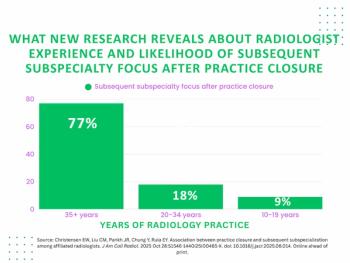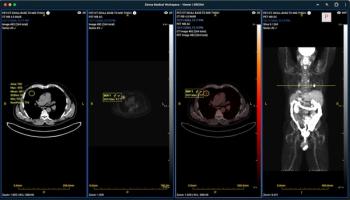
Siemens to target throughput advantages in marketing new digital x-ray systems
Vendor gets FDA nods for Multix FD and Thorax FDSiemens Medical Systems plans to tout the work-flow advantages of digital x-ray technology when it begins selling two new systems that use full-field digital x-ray detectors. The Iselin, NJ, company
Vendor gets FDA nods for Multix FD and Thorax FD
Siemens Medical Systems plans to tout the work-flow advantages of digital x-ray technology when it begins selling two new systems that use full-field digital x-ray detectors. The Iselin, NJ, company is putting the final touches in place on its marketing plans for Multix FD and Thorax FD after the products received 510(k) clearance from the Food and Drug Administration last month (SCAN 5/12/99). Sales of the units should begin in the next several weeks.
Multix FD and Thorax FD are based on amorphous silicon flat-panel detectors manufactured by Trixell, the French joint-venture company formed by Siemens, Philips, and Thomson Tubes Electroniques. Siemens adapted the detectors to conventional analog x-ray systems and debuted the units at last years RSNA meeting (SCAN Special Report 1/99). Multix FD is a table-based system while Thorax FD is a dedicated chest stand.
Although Siemens and Philips are using the same Trixell Pixium 4600 detectors in their respective systems, the vendors products differ in the ways they have integrated the panels.
Siemens designed the FD product line to emphasize throughput and make the new digital x-ray rooms as efficient as possible, according to Thomas Treusdell, product manager for radiographic equipment and flat panel.
In designing Multix FD, Siemens started with its Multix TOP conventional table-based x-ray system, which was first released about two years ago and whose designers knew that digital detectors would be added later. As well as adding the detector itself, Siemens developed a new Windows NT-based workstation for operating the unit.
One unique feature of Multix FD is a detector that can slide out of the table to conduct exams with the body part being imaged directly on top of the detector, Treusdell said. This avoids the need to shoot the exam through the table top and x-ray grid, and could be more convenient for a patient in a wheelchair or on a gurney.
Thorax FD required more engineering work than Multix FD, but as a result features several innovations that should improve its functionality, according to Treusdell. One such feature is the ability to automatically track the overhead x-ray tube to either one of the systems buckys. The unit is also smaller than an analog chest stand, and has a smaller gap between the bottom of the detector panel and the edge of the chest stand.
The workstation used in Multix FD and Thorax FD is the key to the productivity gains that can be achieved with the systems. The computers software was developed with the idea of automating as much as possible the procedures of an x-ray exam, Treusdell said. For example, the workstation can be connected to the hospitals HIS/RIS, enabling users to download patient information to the workstation. The workstation then automatically adjusts the x-ray systems parameters to match the procedure that has been ordered.
You click on the patients name, and it will automatically set up the generator, set up the digital system, and set you up for the first exposure thats usually done in that routine. For a lumbar spine, it could be set up for the AP exposure, Treusdell said. As soon as you make your exposure, everything changes to the oblique. It will step you through the entire procedure.
The system also enables technologists to review exposures instantly to make sure theyre acceptable, a process that can take several minutes with a conventional x-ray unit. Once a procedure has been completed, the study can be sent to a laser printer for output or to a PACS via DICOM storage class connections.
Maximizing productivity will be a key factor in winning market acceptance of the new digital x-ray systems, whether those manufactured by Siemens or those from other companies. Most vendors are pricing digital x-ray systems at levels several times higher than conventional x-ray units due to the additional costs of manufacturing the flat-panel detectors. In Siemens case, Multix FD will be priced at around $450,000 while Thorax FD will carry a price tag of around $350,000. Siemens and other vendors are hoping that radiology departments will find that a single digital x-ray room can take the place of multiple analog units.
(Clinicians) can offset (the price of a unit) by reducing the number of rooms they have, Treusdell said. If you have three or four radiography rooms, you can definitely reduce the number of rooms that youll need.
Siemens believes that its systems compare favorably to other digital x-ray options available. The Trixell panel has a resolution of 143 microns, which is an improvement on the 200-micron resolution of the amorphous silicon panels used by GE Medical Systems in its Revolution XQi system. Unlike the Trixell panels, however, GEs detectors are based on a single piece of glass, and thus do not require imaging tiling. Not surprisingly, Treusdell believes that amorphous silicon is a better approach to x-ray digitization than technology using charge-coupled devices, the method employed by Swissray, Oldelft, and Trex, among other companies.
In addition to the April FDA clearances, Siemens was the beneficiary of more good news last week regarding the status of dpiX, a Palo Alto, CA, flat-panel developer that supplies early-stage thin-film transistor panels to Trixell. A consortium of firms, including Trixell, announced May 17 that they have agreed to acquire dpiX from its parent, Xerox, which in April said it intended to divest the company (SCAN 4/14/99). The deal ensures that dpiX will continue to supply Trixell and other vendors with amorphous silicon panels without interruption (see story, page 1).
© 1999
Newsletter
Stay at the forefront of radiology with the Diagnostic Imaging newsletter, delivering the latest news, clinical insights, and imaging advancements for today’s radiologists.
































